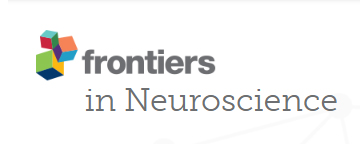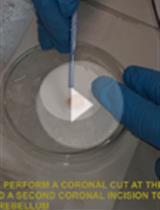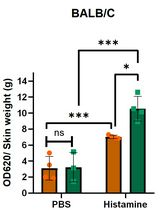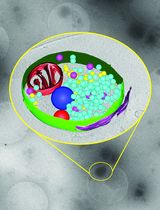- EN - English
- CN - 中文
Preparing Viable Hippocampal Slices from Adult Mice for the Study of Sharp Wave-ripples
成年小鼠海马脑片的制备及其锐波波纹的研究
发布: 2020年10月05日第10卷第19期 DOI: 10.21769/BioProtoc.3771 浏览次数: 5575
评审: Akira KarasawaCarey Y. L. HuhAnonymous reviewer(s)
Abstract
We describe a protocol for preparing acute brain slices which can produce robust hippocampal sharp wave-ripples (SWRs) in vitro. The protocol is optimized for its simplicity and reliability for the preparation of solutions, slicing, and recovery incubation. Most slices in almost every mouse prepared though the protocol expressed vigorous spontaneous SWRs for ~24 h, compared to the 20-30% viability from "standard" low sodium slicing protocols. SWRs are spontaneous neuronal activity in the hippocampus and are essential for consolidation of episodic memory. Brain slices reliably expressing SWRs are useful for studying memory impairment and brain degeneration diseases in ex vivo experiments. Spontaneous expression of SWRs is sensitive to conditions of slicing and perfusion/oxygenation during recording. The amplitude and abundance of SWRs are often used as a biomarker for viable slices. Key improvements include fast circulation, a long recovery period (3-6 h) after slicing, and allowing tissue to recover at 32 °C in a well perfused incubation chamber. Slices in our custom-made apparatus can express spontaneous SWRs for many hours, suggesting a long period with balanced excitation and inhibition in the local networks. Slices from older mice (~postnatal 180 days) show similar viability to younger (postnatal 21-30) mice.
Keywords: Brain slice (脑片)Background
Acute brain slices have been an invaluable preparation for electrophysiology and other neuroscience studies. While there is a vast body of literature describing the usage of brain slices, protocols for reliably producing viable slices are usually discussed in less detail. Slices from older animals are typically less viable. Viability of the brain slices is often described using healthy cell morphology and electrophysiological properties of the neurons. However, healthy looking neurons in the tissue do not always translate to normal network behaviors. For example, thin slices prepared with the standard sucrose replacement protocol (e.g., Aghajanian and Rasmussen, 1989; Ye et al., 2006) provide morphologically healthy cells for patch studies, but do not express spontaneous network activity such as hippocampal sharp-wave ripples (SWRs).
SWRs are spontaneous neuronal population events that occur in the hippocampus during sleep and quiet restfulness (for review see Buzsáki, 2015). An experience, such as an exploration of the environment, is registered in the hippocampus as sequential activations of neuronal assemblies (a.k.a “place cell assemblies”). These sequences are then re-activated in SWRs during sleep or quiet restfulness (off-line states), and contribute to the consolidation of the memory (Wilson and McNaughton, 1994; Lee and Wilson, 2002; Ji and Wilson, 2007). Suppression of SWRs impairs hippocampus dependent episodic memory (Ego-Stengel and Wilson, 2010), suggesting that SWRs are important for the reactivation of experience related to neuronal ensembles in the absence of related sensory input.
Spontaneous SWRs also occur in vitro in hippocampal slices (Kubota et al., 2003; Maier et al., 2003 and 2009; Colgin et al., 2004; Behrens et al., 2005; Miyawaki et al., 2014; Keller et al., 2015). However, in standard submerged-type recording chambers, SWRs are rarely seen, due to insufficient perfusion. Vigorous perfusion on both sides of the slice seems to be an essential condition for providing adequate oxygen that allows for the SWRs to occur (Wu et al., 2005; Hájos et al., 2009; Maier et al., 2009).
In our experience, slices prepared with standard high-sucrose low-sodium protocol (Aghajanian and Rasmussen, 1989) only have a lower probability (20-50%) of expressing spontaneous SWRs. Slices from mice older than postnatal (P) 30-days have a further reduced probability of expressing SWRs and often fail to induce LTP. Extending the recovery time after slicing often helped. Consistent with (Maier et al., 2009), we also observed that SWRs were rarely expressed in conventional slice incubation chambers, which have passive fluid convection or oxygen bubble induced convection (e.g., Brain Slice Keeper-4 apparatus, Automate Scientific). A forced fluid circulation with a small pump significantly increased SWR expression. We have tested 198 slices from 35 mice of P 35 to P180 days of age, and every animal tested showed spontaneous SWRs, including 6-month-old 5xFAD mice with obvious amyloid plaques and slices from mice that have undergone severe traumatic brain injuries.
Fast circulation may be important for two reasons: 1. Thick slices (350-500 μm) are essential for preserving SWR generating circuits. Fast circulation on both sides of the slice can improve the oxygen delivery into the thickness of the tissue. 2. SWRs are spontaneous activity occurring 1-2 times/second. Continuous activation of large number of neurons requires more oxygen provided by fast circulation.
Our protocol is also aimed at its simplicity, i.e., using stock solutions to minimize the solution preparation time (< 30 min), using simple low sodium high sucrose cutting solution without unstable compounds like NMDG (Tanaka et al., 2008) and antioxidants (Brahma et al., 2000), and omitting the complex procedure of intra-cardiac perfusion and protective recovery protocol (Ting et al., 2014 and 2018). Some of our research papers using the protocol have been published (Jiang et al., 2018; Sun et al., 2018; Li et al., 2019).
Materials and Reagents
- Paper towel
- Glass pipet for local field potential electrode, 1.5 mm outer diameter x 1.1 mm inner diameter, 7.5 cm long borosilicate glass pipet with inner filament (Sutter Instruments, catalog number: BF150-110-7.5 )
- Nylon mesh (Component supply UMN-600), glued onto the bottom of the slice holder
- Silicon tubing (1/4-3/8, VWR , catalog number: 89403-862), for connecting the pump and the top chamber
- Disposable Transfer Pipettes (Thermo Scientific, Samco 3.2 ml) for slice transferring between incubation and recording chamber
- Animals
Wildtype Mice (C57BL/6J, RRID: IMSR_JAX :000664, Jackson Labs) and transgenic 5xFAD mice (RRID:MMRRC_034840-JAX, Jackson Labs) (Oakley et al., 2006) were used. Mice for experiments were from our Georgetown colony, they were kept on a standard 12 h light/dark cycle, food and water were provided ad libitum, with all experimental procedures performed in accordance with the guidelines of the Georgetown University Animal Care and Use Committee. - Super glue (liquid form, Loctite, catalog number: 1775049) for gluing the brain during slicing
- Sucrose (ACS Reagents, Fisher Scientific, catalog number: S5-500 )
- KCl (ACS Reagents, Fisher Scientific, CAS: 7447-40-7 )
- MgSO4 (ACS Reagents, Fisher Scientific, CAS: 7487-88-9 )
- CaCl2 (ACS Reagents, Fisher Scientific, catalog number: C79-500 )
- Glucose (ACS Reagents, Sigma-Aldrich, catalog number: G8270-5KG )
- NaH2PO4 (ACS Reagents, Sigma-Aldrich, catalog number: S0751-1KG )
- HEPES (ACS Reagents, Fisher Scientific, catalog number: BP310-1 )
- NaCl (ACS Reagents, Sigma-Aldrich, catalog number: S5886-10KG )
- Carbogen (95% O2, 5% CO2, tank and regulator available from local gas suppliers)
- NaHCO3 powder (ACS Reagents, Fisher Scientific, catalog number: S233-500 )
- Slice cutting ACSF solution (see Recipes)
Stock 1: Sucrose
Stock 2: Cutting ACSF
Stock 3: NaHCO3 powder - Incubation/recording ACSF (see Recipes)
Equipment
For slice preparation
- Vibratome slice cutter (Leica, model: VT1000S )
- Water bath (e.g., Southwest Science , model: SHW10LD 10 Liter Bath)
- Digital Thermometer ( VWR Traceable Double Thermometer, catalog number: 23226-656 , or any type with 0.1 °C accuracy)
- Custom-made incubation chamber illustrated in Figure 2, made of 1/4 Plexiglass (acrylic) sheet, obtained from McMaster-Carr
- Slice holder is cut from an egg crate light diffusor panel with 1/2 x 1/2 x 1/2 cells (e-Plastics SKU: W/EGG.500X2X4)
- 600 ml glass beaker ( VWR , catalog number: 89001-078 )
- Carbogen blower (e.g., Air Stone Cylinder Bubble Diffuser from Amazon) three of them are needed (two for incubation gas blowers for incubation chamber and recording ASCF flask, one used as a filter for ACSF circulation in recording chamber)
- Low voltage, low flow rate pump, available from a solar powered mini water fountain/bird bath kits (Amazon). The pump provides a flow of ~1,000 ml/min, and uses a safe low voltage power supply (below)
- Variable DC power supply for the pump (Circuit specialist CSI5003XE, or B&K Precision 1550 DC Power Supply)
- Surgical scissors for mouse decapitation (WPI, catalog number: 501743G )
- Spring scissors (WPI, catalog number: 15905G ) for cutting through skull and extracting the brain
- Size 4 watercolor pointed brush (Office depot 596713) for transferring brain slices
- Dumont #7 student forceps (Fine Science Tools, catalog number: 97797-00 ) for extracting the brain
- Tapered Spatula (PTFE coated, VWR , catalog number: 10806-412) for extracting the brain
- Dumont #5 student forceps (Fine Science Tools, catalog number: 91150-20 ) for adjusting slice position in recording chamber
For SWR recording
While most electrophysiology rigs can be used for recording SWRs, perfusion of both sides of the slice with a high circulation rate is essential. See Maier et al. (2009) and Hájos et al. (2009) for the modification of conventional chambers on patch recording rigs. Listed below are parts for a low-cost local field potential recording system. The system is easy to use and reliable for recording many hours of SWRs from one slice.
- Local field potential recording chamber
A chamber that can perfuse both sides of slice is important. See procedures and data recording sections. Figure 3 illustrates the flow directions in the custom-made recording chamber. - LFP amplifier, 1000x amplification with a probed head stage (e.g., Warner Instruments, model: DP 311A )
- Data acquisition system to digitize the data (e.g., NeuronNexue smart box, allowing multiple channels with an electrode array)
- An oscilloscope (e.g., Digikey, 2250-SDS1022-ND ) for positioning electrode
- An audio monitor (A-M Systems 3300) for positioning the electrode
- Manual micromanipulators (SD Instruments SKU MX160 ) and magnetic stands for holding the manipulators (SD Instruments)
- 625 nm LED (Thorlabs, model: M625D3 ) for slice illumination under the chamber
- Pipet puller (Sutter, model: P97 ) for pulling ultra-low impedance pipet for local field potential (LFP) recordings
- LFP recording and Stimulation electrodes (low impedance (~500K) glass pipette pulled by the pipette puller). Low electrode impedance (50-500K) is important for low noise recording.
- Peristaltic pump, for ACSF circulation (e.g., Pulsatron Dolphin Series Peristaltic Metering Pump, 60.0 gpd/25 PSI, Norprene tubing, .25" ID x .44" OD).
- Plastic tubing for connecting pump and recording chamber perfusion ( VWR , catalog number: 89403-850 , 3/32-5/32 Tygon tubing)
- Tubing clamp flow regulator ( VWR Talon® Regular Hosecock Clamp), for regulating perfusion rate of the recording chamber
- 1000 ml glass flask for circulating ACSF perfusion of the recording chamber ( VWR , catalog number: 75804-652 )
- Stereo zoom dissecting microscope, 10-40x zoom, available from Olympus, Nikon, or American microscopes (SKU: V-SM-3 SD Instruments)
- Recording bench (Newport, catalog number: IG-22-2 )
This 2 x 2 ft optical breadboard can be set up on standard laboratory bench top. Recording the LFP from SWRs does not need a vibration isolation table. A Faraday cage may also be avoided if a low impedance glass electrode is used and there is no instrument power cord within 30-inches of the set up.
Procedure
文章信息
版权信息
© 2020 The Authors; exclusive licensee Bio-protocol LLC.
如何引用
Liu, L., Zhou, X. and Wu, J. (2020). Preparing Viable Hippocampal Slices from Adult Mice for the Study of Sharp Wave-ripples. Bio-protocol 10(19): e3771. DOI: 10.21769/BioProtoc.3771.
分类
神经科学 > 基础技术 > 快速制片
细胞生物学 > 组织分析 > 生理学
您对这篇实验方法有问题吗?
在此处发布您的问题,我们将邀请本文作者来回答。同时,我们会将您的问题发布到Bio-protocol Exchange,以便寻求社区成员的帮助。
Share
Bluesky
X
Copy link













